Ipanema |
|||||||||||||||||||||||||
 |
 |
||||||||||||||||||||||||
Crocheted top with clover and lace pattern. The piece is worked in DROPS Cotton Light. Sizes S - XXXL.
DROPS 190-2 |
|||||||||||||||||||||||||
|
INFORMATION FOR THE PATTERN: PATTERN: See diagrams A.1 to A.4. CROCHET INFO-1: The first row on each clover leaf (= 1 treble crochet, 3 chain stitches, 1 treble crochet, 3 chain stitches, 1 treble crochet, 3 chain stitches, 1 treble crochet in the same treble crochet) is worked in the middle double treble crochet of the previous clover leaf - see A.2. CROCHET INFO-2: The first treble crochet at the beginning of the row/round is replaced by 3 chain stitches. Finish the row/round with 1 slip stitch in the 3rd chain stitch at the beginning of the row/round. The first double crochet at the beginning of the row is replaced by 1 chain stitch. ---------------------------------------------------------- TOP: First the clover pattern is worked from side to side at the bottom, then the top is worked upwards in the round as far as the armholes. Here the piece is divided and the front and back pieces are worked separately. Work 12 chain stitches (including 5 chain stitches to turn) with Cotton Light and hook size 3.5 mm. Read CROCHET INFO-1! Continue by working according to A.1 until you have worked 1 repeat in height. Then repeat rows 7-12 until the piece measures approx. 100-106-112-124-136-148 cm – finish after row 12. Sew the clover edge together to make a ring (seam = side of the top). Then continue working upwards in the round, THE PIECE IS NOW MEASURED FROM HERE! Crochet up 198-210-222-246-270-294 treble crochets around the treble crochets from the long-side in A.1. Then work according to A.3 – read CROCHET INFO-2. Continue this pattern upwards. Insert 2 marker threads in the piece, 1 at the beginning of the round and 1 after 99-105-111-123-135-147 treble crochets (= sides). When the piece measures 2 cm decrease 1 treble crochet group (= 3 treble crochets or 1 treble crochet + 2 chain stitches) in each side, decrease before both marker threads. Diagram A.4 shows how to decrease in the pattern. Repeat the decrease upwards every 4 cm; decrease alternately before and after the marker threads in the sides, i.e. the first time you decrease 1 treble crochet group before the marker threads, the second time you decrease 1 treble crochet group after both marker threads. Decrease a total of 6 times in each side of the top = 162-174-186-210-234-258 treble crochets/chain stitches. When the piece measures 25-26-27-28-29-30 cm, adjust so that the next round to be worked is the first round in A.3, divide the piece for the front and back pieces. Cut the strand. FRONT PIECE: Skip the first 6-6-9-12-18-21 treble crochets, work A.3 over the next 70-76-76-82-82-88 treble crochets (= 23-25-25-27-27-29 repeats of A.3 + 1 treble crochet). Turn and work back. Continue this pattern upwards. When the piece measures 36-38-40-42-44-46 cm work over just the first 19-22-22-22-22-25 treble crochets/chain stitches on the row = right shoulder. Continue until the piece measures 42-44-46-48-50-52 cm, cut and fasten the strand. Work the left shoulder in the same way, i.e. work over just the last 19-22-22-22-22-25 treble crochets/chain stitches on the row. The 32-32-32-38-38-38 treble crochets/chain stitches not worked = neck. The piece measures a total of 54-56-58-60-62-64 cm. BACK PIECE: Skip the first 11-11-17-23-35-41 treble crochets after the front piece, work A.3 over the next 70-76-76-82-82-88 treble crochets (= 23-25-25-27-27-29 repeats of A.3 + 1 treble crochet). Turn and work back (there are now 11-11-17-23-35-41 treble crochets in each side which are not worked (= armholes). Continue A.3 upwards. When the piece measures 30-32-34-36-38-40 cm divide the back piece so that you have a split mid back. RIGHT BACK PIECE: Now work over just the first 35-38-38-41-41-44 treble crochets; work A.3 over the first 33-36-36-39-39-42 treble crochets/chain stitches and finish with 2 treble crochets towards mid back. When the piece measures 36-38-40-42-44-46 cm work over just the first 19-22-22-22-22-25 treble crochets/chain stitches on the row = right shoulder. The 16-16-16-19-19-19 treble crochets not worked = neck. Continue until the piece measures 42-44-46-48-50-52 cm, cut and fasten the strand. LEFT BACK PIECE: Now work over just the last 35-38-38-41-41-44 treble crochets; work 1 treble crochet towards mid back, work A.3 over the next 33-36-36-39-39-42 treble crochets/chain stitches and finish with 1 treble crochet towards the side. When the piece measures 36-38-40-42-44-46 cm work over just the last 19-22-22-22-22-25 treble crochets/chain stitches on the row = left shoulder. The 16-16-16-19-19-19 treble crochets not worked = neck. Continue until the piece measures 42-44-46-48-50-52 cm, cut and fasten the strand. ASSEMBLY: Sew the shoulder seams. CROCHET EDGE AROUND THE ARMHOLES: Start at bottom of armhole. Work 1 double crochet,* skip forward approx. 2 cm, work 7 treble crochets around the next treble crochet, skip forward approx. 2 cm, work 1 double crochet around the next treble crochet *, repeat from *-* and finish with 1 slip stitch in the double crochet at the beginning of the round. Work in the same way around the other armhole. CROCHET EDGE AROUND THE NECK: Start mid back. Work 1 double crochet, * 3 chain stitches, skip forward approx. 1 cm, work 1 double crochet *, repeat from *-*. ASSEMBLY -2: Sew a button to the top of the split mid back; the button is buttoned through 2 treble crochets. |
|||||||||||||||||||||||||
Diagram explanations |
|||||||||||||||||||||||||
|
|||||||||||||||||||||||||

|
|||||||||||||||||||||||||
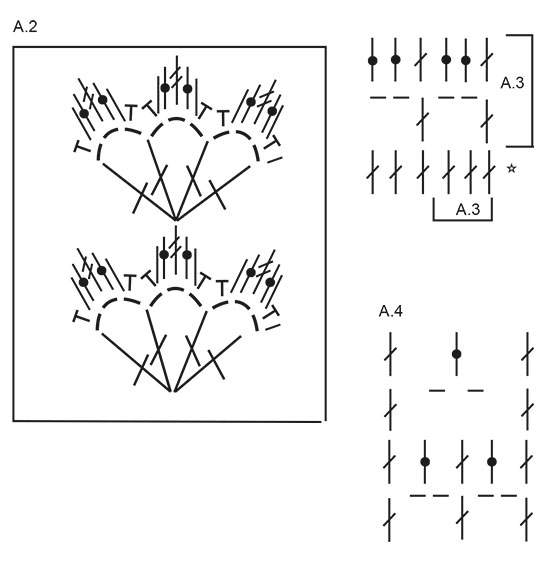
|
|||||||||||||||||||||||||
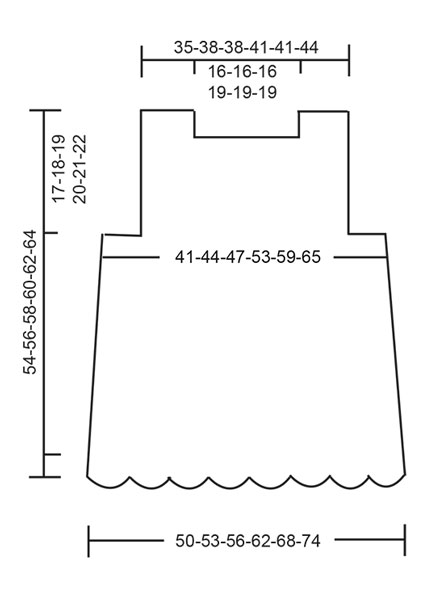
|
|||||||||||||||||||||||||
|
Have you made this or any other of our designs? Tag your pictures in social media with #dropsdesign so we can see them! Do you need help with this pattern?You'll find tutorial videos, a Comments/Questions area and more by visiting the pattern on garnstudio.com. © 1982-2024 DROPS Design A/S. We reserve all rights. This document, including all its sub-sections, has copyrights. Read more about what you can do with our patterns at the bottom of each pattern on our site. |
|||||||||||||||||||||||||







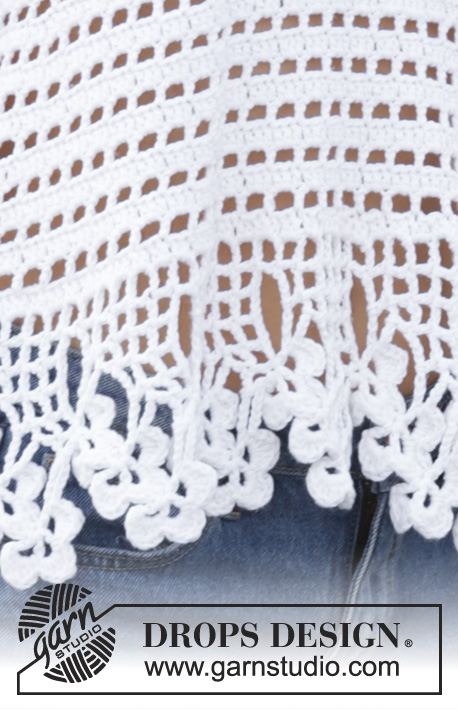




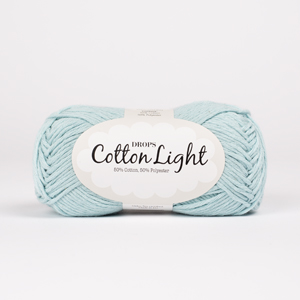









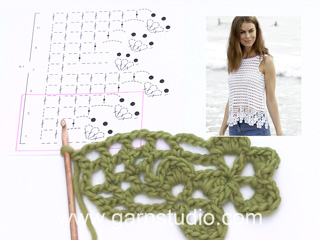





















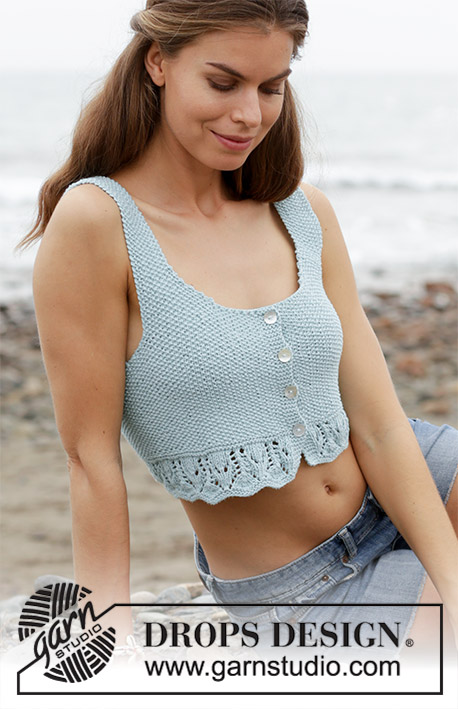






Comments / Questions (40)
Im Diagramm A4 wird von 7 Stäbchen auf 3 Stäbchen abgenommen, also um 4 Stäbchen reduziert, nicht wie angegeben um 1 Mustersatz, = 3 Stäbchen, wenn ich das insgesamt 6x wiederhole, dann nehme ich 48 statt 36 Maschen ab
07.05.2020 - 06:37DROPS Design answered:
Liebe Karin, es stimmt so auch wenn Sie es schreiben, aber wenn man in A.4 abnimmt, dann haben Sie nur noch 3 Stäbchen, dh Sie haben 1 Stb-Gruppe abgenommen = 1 Stäbchen + (2 Stäbchen um den Luftmaschenbogen bzw 2 Luftmaschen). Viel Spaß beim häkeln!
07.05.2020 - 10:04I love this pattern (I love most of your patterns!) but I'm too old to show my arms and would love to make it with sleeves. Do you happen to know if there is another pattern I could use and adapt the sleeves (using the same pattern stitches as this pattern) to fit?
05.05.2020 - 15:38DROPS Design answered:
Dear Mrs Williamson, you will find here all our patterns with same crochet hook size that could inspire you to make the top bottom up from the edge - you might have to make some other adjustements. Happy crocheting!
05.05.2020 - 16:51Mein Garn ist anders, so dass ich mich nicht nach den Stäbchenzahlen richten kann. Ich hätte gern gewusst, ob die Maßangaben für das Vorderteil oder Rückenteil gelten. Ist der Schnitt hinten anders? Schlitz? Bitte ein Foto vom Rücken wäre super!!,
14.04.2020 - 17:45DROPS Design answered:
Liebe Dameuna, beim Rückenteil haben Sie einen Schiltz, deshalb wird der Rückenteil in 2 Teile beendet. Die Maßen in der Skizze passen die Anleitung und die Maschenprobe an. Hier lesen Sie mehr über Maschenprobe und hier über die Maßskizze. Viel Spaß beim häkeln!
15.04.2020 - 07:56Salve volevo fare alcune domande relative al modello. Ho finito il motivo a trifogli e ho ripreso 198 maglie. Ho iniziato a fare il diagramma A.3. e dopo 2 cm ho iniziato le diminuzioni. Vanno fatte solo sui lati dove ci sono i 2 segni? Il diagramma A4 deve essere completato tutto in orizzontale? Ed infine volevo chiedere se dopo aver fatto la prima diminuzione, come devo proseguire il giro successivo?
25.03.2020 - 16:38DROPS Design answered:
Buongiorno Alessia. Deve diminuire dove ci sono i segni, alternando una volta prima e una volta dopo il segno. Il diagramma A4 viene lavorato tutto in orizzontale. Terminato A4, lavora su queste maglie come indicato sulla riga di A3 che sta lavorando sulle altre maglie. Buon lavoro!
27.03.2020 - 16:26Un sito meraviglioso con bellissimi modelli, lo uso spesso e vi ringrazio di cuore per quello che offrite .
17.03.2020 - 10:33Buongiorno sono Paola, sto eseguendo il modello ipanema ma sinceramente non riesco a capire come si fanno le diminuzioni sui lati, sono ferma con il lavoro. Grazie per il vostro aiuto e complimenti per il sito, meraviglioso.
17.03.2020 - 10:30DROPS Design answered:
Buongiorno Paola. Sulla prima riga di A.4 lavora: 1 maglia alta, 2 cat, 1 maglia alta , 2 cat, 1 maglia alta. Riga 2: 1 maglia alta in ogni maglia alta e 1 maglia alta intorno agli archi di catenelle (e non 2 maglie alte come in A.3). Riga 3: 1 maglia alta nella maglia alta , 2 cat, saltare 3 maglie alte e finire con 1 maglia alta nella maglia alta successiva. Riga 4: 1 maglia alta nella maglia alta, 1 maglia alta nell’arco di catenelle e 1 maglia alta nella maglia alta successiva. Buon lavoro!
17.03.2020 - 17:22Jeg hækler str. medium - alle mål passer med opskriften, men jeg synes, det virker som om toppen bliver meget stor, er det en meget stor medium? - jeg har hæklet hele kløvermønstret og er gået i gang med A3 omgangene. Så det er det nederste af toppen, jeg vurderer - men som nævnt, så passer det, jeg har hæklet med de mål, der er opgivet.
07.08.2019 - 22:20DROPS Design answered:
Hej Henriette, du finder alle mål på toppen i måleskitsen nederst i opskriften. Vælg den størrelse som har de mål som passer til dig. God fornøjelse!
09.08.2019 - 08:53Buona sera. Sono arrivata alla fine dei 25 cm e devo iniziare a dividere il lavoro. Ma nn capisco se devo dividere 81 maglie x parte e poi partire dalla 7 e iniziare a lavorare le 70 m.a.facendo il giro m.a. e 2 cat saltando 2 maglie. Poi tornare indietro e proseguire con a3 fino a 36 cm . Corretto? Grazie
30.07.2019 - 23:24DROPS Design answered:
Buongiorno Laura. Sì, è corretto come ha indicato. Buon lavoro!
30.07.2019 - 23:57C'è un errore nello schema delle diminuzioni, nel terzo giro i punti alti intorno alla catenella devono essere 2 e non 1, altrimenti si calano 4 punti ogni volta e non 3.
24.07.2019 - 13:23Ihana ohje, helppo aloittelijallekin.
03.06.2019 - 10:29